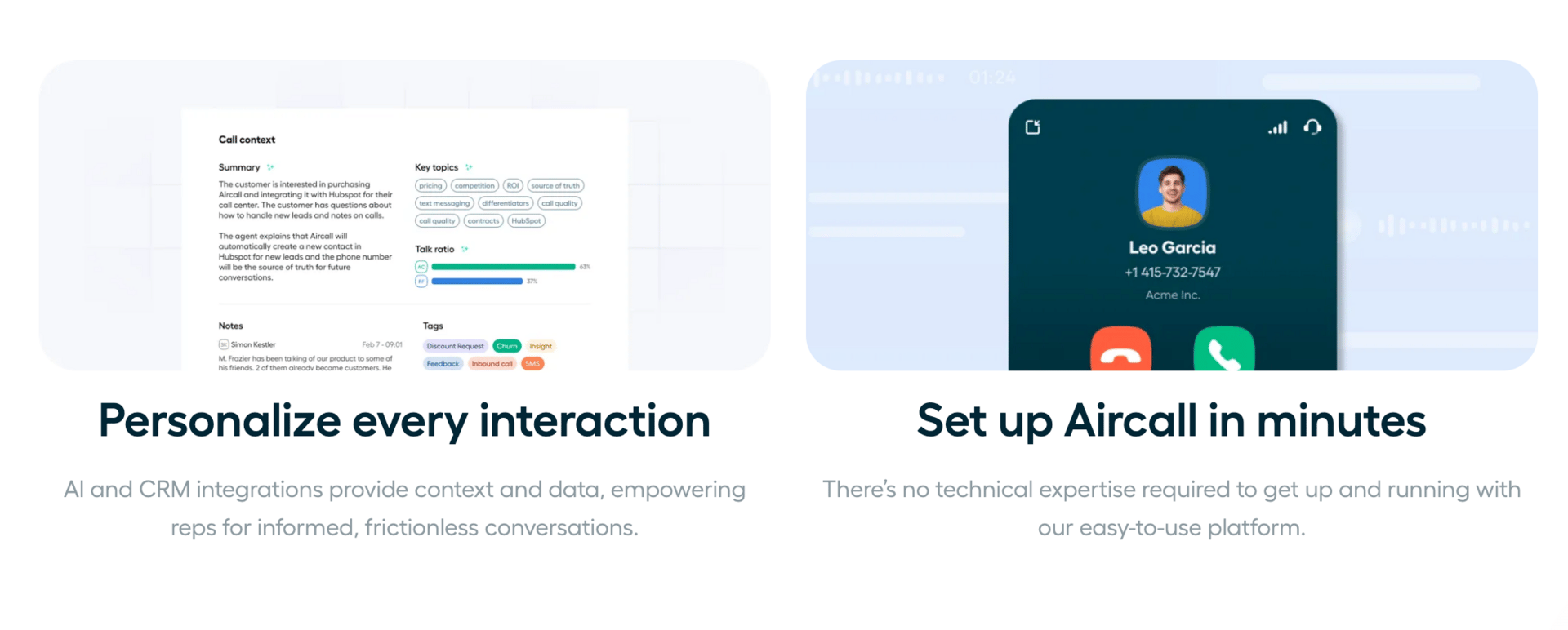- SalesDaily for Leaders
- Posts
- ⚙️ The future of RevOps
⚙️ The future of RevOps
How leading teams rebuilt RevOps with AI
Welcome to SalesDaily for Leaders: your weekly briefing packed with actionable insights to help you manage better, coach smarter, and drive results in B2B sales.
Every Sunday, we provide the latest strategies, resources, and ideas for leading high-performing teams and staying ahead in today’s competitive landscape.
Let’s dive in!
In today’s issue:
Denise Persson & Chris Degnan: Rebuilding sales productivity with AI
Tessa Whittaker: The real AI unlock is operational rigor
Dominic Freschi: Why AI fails in ops (and how to fix it)
Marc Roberge: The future of RevOps
Sales leaders lose visibility the moment reps pick up the phone.
Aircall fixes that.
It gives you real-time insight into every call, every conversation, and every coaching opportunity - without sitting next to your reps.
The result: Better coaching, faster ramp times, and full pipeline visibility.
Teams at Uber, Birchbox, and Sendinblue use it to scale calling without losing control.
👉 Learn more at Aircall.com
How Snowflake rebuilt sales productivity with AI
Denise Persson and Chris Degnan detail how Snowflake transformed marketing and sales using AI, making it operational, secure, and ROI-driven at enterprise scale.
How Snowflake scales AI without chaos
It’s not enough to say “go try AI.” That creates mess, not momentum.
✔ Snowflake formed an AI Council with 30 curious volunteers (across teams) dedicating 20% of their time to test, learn, and roll out new use cases
✔ Every quarter, they host an AI Day to educate the broader org and introduce tools that passed internal governance and security review
➤ CEO buy-in is essential. AI has to be a company priority, not just a side project
This top-down support + structured bottom-up experimentation = scaled adoption with guardrails.
AI as task automation = huge efficiency gains
Chris Degnan kept it simple: AI is a task automator, and that’s what makes it powerful.
✔ Global support saves 418 hours/week
✔ Marketing cut time spent on scripting, prep, and localization by 90%
✔ AI removes busywork so teams can focus
If a tool isn’t saving money or making money, it doesn’t last.
Game-changing models built internally
Snowflake developed two proprietary agents using LLMs and Snowflake Cortex:
➤ Campaign Agent: Delivers real-time ROI for every campaign
⇢ Enables in-quarter resource shifts (e.g. to fix territory pipeline gaps)
⇢ Saves budget, boosts returns
➤ Competitive Intelligence Agent: Custom talking points on demand
⇢ “I’m competing against X for Y use case at Z company” → tailored sales ammo instantly
Without this, enablement at scale would be nearly impossible.
Sales AI is only as good as your data
Snowflake’s mantra: “No AI strategy without a data strategy.”
✔ Snowflake is always customer zero
✔ All internal tools (like Raven) run on governed, centralized, Snowflake-hosted data
✔ Every tool must pass security reviews, even internal experiments
This builds trust, both internally and with enterprise customers wary of LLM misuse.
Sales intelligence without the dashboard chase
Raven is their go-to-market AI assistant. Every rep uses it before customer meetings.
Ask: “What’s the 360 view on Acme Corp?”
Get: Usage trends, risk signals, open tickets, opportunities, blockers - in seconds.
➤ Saves time, yes
➤ But more importantly: it raises the bar on preparation and customer understanding
Even the CEO uses Raven before customer meetings.
Certify your SEs
Chris was asked: “How do you know if your sales engineers are any good?” He didn’t have a clear answer.
So they certified every SE, even the 4th-line leaders.
Then they rolled out Cursor AI: custom demo creation in weeks, not months.
➤ Because the team was technically credible, the AI rollout worked
✘ Without that foundation, automation would have flopped
Org structure matters
Snowflake eliminated data silos by centralizing all analysts under the Chief Data Officer.
Those analysts are embedded in GTM functions but aligned centrally.
➤ This enabled consistent data access, no duplication, and faster AI development
The result: sales, marketing, and execs all look at the same metrics.
Hiring for AI readiness = hire for curiosity
Denise and Chris now prioritize adaptability over resume keywords.
✔ Ask: “How do you learn?” “How do you innovate yourself?”
✔ They hire people who ask questions, explore tools, and adapt fast
➤ This mindset matters more than past experience with tools
And when you’re seen as AI-forward, top talent comes to you.
Mistakes to avoid
“Everyone experiment with AI” → chaos
⇢ Uncoordinated efforts waste time and duplicate workNo ROI? No AI.
⇢ Adoption won’t scale if tools don’t save or generate moneySiloed teams = stalled AI
⇢ Consolidation is critical to move fast with consistencySkipping security and governance
⇢ Especially in enterprise, non-compliant tools won’t flyAssuming SEs are technical enough
⇢ Certify first. Then deploy tools that assume real skill.
What drives AI success in sales orgs
You need both:
✔ Executive mandate (top-down)
✔ Structured innovation (bottom-up)
If either is missing, progress stalls.
👉 Power up your sales team
If you lead a sales team, run training sessions, or coach reps - this is for you.
With SalesDaily Elite, you get full white-label rights to my complete library of sales cheat sheets, guides, and templates.
✔️ Editable Canva files you can brand as your own
✔️ Ready-to-use for team onboarding, and workshops
✔️ Built for high-impact sales team enablement
Stop wasting time building resources from scratch.
The real AI unlock is operational rigor
Tessa Whittaker outlines how she’s transforming RevOps at ZoomInfo with AI, by first mastering operational rigor.
Build RevOps like a product org
Before layering in AI, Tessa rebuilt the entire operating model of her team using product management principles:
➤ First step: Understand what you’re working on
She started by asking her team: What are we doing? How do we prioritize? How do we intake requests?
None of it was documented. No roadmap. No clear intake. No capacity model.
So she rebuilt it from scratch, using a simple Google Sheet.
✔ Mapped current projects and guessed at priorities
✔ Estimated team capacity with sprint data
✔ Documented a sprint cadence and standardized releases
➤ Once the manual process worked, she systematized it
She moved the system into Jira, launched a centralized intake form, and created a repeatable process for stakeholder reviews and prioritization.
Key idea: Don’t chase quick wins for the business if your team is operating in chaos. Fix the system first so you can deliver consistently.
Use a maturity scale to measure readiness for AI
Tessa created a 0–5 RevOps maturity scale to benchmark the team’s operational health and decide when AI was appropriate.
Here’s how it works:
0 – Ad hoc and manual
1 – Manual but defined
2 – Systematized rigor
3 – AI-augmented workflows
4 – Agentic assistance (AI supports execution)
5 – AI first, autonomous operations
AI doesn’t enter until level 3.
⇢ You need documented processes, a working system of execution, and strong operational hygiene before AI can add value.
She also built this scale across three other areas:
• Data maturity
• GTM execution maturity
• Operational excellence
You can’t automate what isn’t defined. You can’t add AI to a broken process. And you definitely can’t rely on AI with bad data.
How ZoomInfo is using AI internally (not for sales, for RevOps)
Once her team reached systematized rigor (level 2), they looked at their most time-consuming tasks.
The biggest time sink?
↳ Gathering requirements
Most intake meetings were inefficient. So they built a requirements-gathering agent.
✔ It chats with stakeholders to extract business needs
✔ It asks probing follow-up questions
✔ It rewrites responses into a usable user story
✔ It identifies missing information
✔ It slots directly into Jira
But that’s just the start.
They’re now building a system where the agent predicts sprint load, prioritizes based on goals, and flags delays or over-capacity.
A system for prioritization that scales
To avoid the “loudest voice wins” problem, Tessa implemented centralized stack-ranking:
• Company goals sit at the top
• CRO-level priorities follow
• Then SVP requests get ranked in one central view
• Every stakeholder gets monthly reviews to align
That structure ensures RevOps works above and beyond capacity, but only on what matters most.
And they’re building an AI agent that can auto-score each request based on:
→ Strategic relevance
→ Existing roadmap alignment
→ Run-the-business vs. change-the-business work
She didn’t just teach AI, she made it mandatory
Initially, her team didn’t engage much with AI tools.
So she made one thing mandatory:
✔ Every team member had to build one AI agent
✔ It had to support internal workflows and team productivity
✔ They ran an org-wide hackathon
That’s when things clicked. Once people saw how AI could support their day-to-day tasks, adoption skyrocketed.
This only works because the team is built to scale
Tessa called this out: If you're at a small startup, your RevOps people are generalists. Everyone’s doing intake, documentation, user stories, and stakeholder comms.
At ZoomInfo, each function is specialized:
• Technical systems teams
• Process and product managers
• Business partners for each go-to-market area
• A central operations leader to stitch it together
That separation is what allows scalable execution.
Partnering with:
Navan: The leading travel and expense platform
Smartlead: Automate outreach without losing the human touch
Close: Manage relationships and scale outreach in one smart CRM
La Growth Machine: Multichannel prospecting that actually scales
(include affiliate links)
Why AI fails in ops (and how to fix it)
Matt Volm and Dominic Freschi break down why most AI initiatives flop, and how to fix them with structure, not just shiny tools.
Why AI keeps failing in RevOps
AI in sales ops sounds exciting. But in reality, most projects fall apart because they’re missing the basics:
✘ No clear goals or KPIs
✘ Dirty, unstructured data
✘ Overhyped expectations from generic AI tools
The result? Random projects, shallow productivity gains, and zero measurable ROI.
When AI makes things harder, not easier
Everyone expects AI to streamline work. But without the right system, it adds friction:
→ Manual prompting with half-baked data
→ Fixing bad or hallucinated outputs
→ Copy-pasting between disconnected tools
Example: Teams use ChatGPT to draft emails, then spend 30 minutes fixing errors and formatting.
Automation ≠ AI
Important distinction:
✔ Automation = Rule-based, predictable workflows
✔ AI = Creative but unreliable suggestions
✔ AI agents = Tools that take action in your systems (e.g. update records, build reports)
If you want scalable, trustworthy AI, you need structure around it.
The 6-pillar framework for AI that works
To move beyond experiments, build these layers around your models:
1. Context orchestration
AI is only as good as the inputs.
Clean and de-dupe your data
Filter before you prompt
Avoid token waste from junk records
Bad data = bad AI. Always.
2. Prompt management
Prompts aren’t one-offs. They’re assets.
Track versions and test them
Separate brainstorming prompts from production-ready ones
Watch for prompt injection risks
Treat prompts like code. That’s how you scale.
3. Model orchestration
No single model wins every task.
Use different models (GPT, Claude, Gemini) for different jobs
Rotate to reduce bias and catch errors
Match strengths to task types
Example: Use Claude for summaries, GPT for ideation.
4. Output validation
Never fully trust an AI output.
Auto-check for hallucinations or bad links
Flag strange results for human review
Compare outputs across models when accuracy matters
AI should support, not sabotage, your workflows.
5. System integration
Insights are worthless if they live in isolation.
Convert AI outputs into CRM-ready fields
Push data into Salesforce, Outreach, etc.
Pull data from your systems to feed the AI
Connect the pipes. Or you’ll be stuck copying and pasting.
6. Track cost and performance
If you’re not measuring, you’re guessing.
Monitor token and model costs
Track how often outputs are actually usable
Measure time saved and actions taken
Otherwise, you’ll waste budget on a black box.
Avoid these traps
✘ Thinking AI will magically reduce workload
✘ Prompting on top of dirty data
✘ Using the same model for everything
✘ Skipping validation or system integration
Don’t scale AI without a structure
Start small, but start right. This framework helps you move from experiments to impact - from shiny object to real business value.
TO-GO
Meredith Chandler: The #1 reason sellers leave a job
Matt Green: So, you cap commissions…
Jason Bay: How to prevent high voluntary turnover rates
Marc Roberge: The future of RevOps
QUOTE OF THE DAY
"Most managers think their job is to tell reps what to do. It’s not. Your job is to make them think."
PODCASTS
HUMOR





